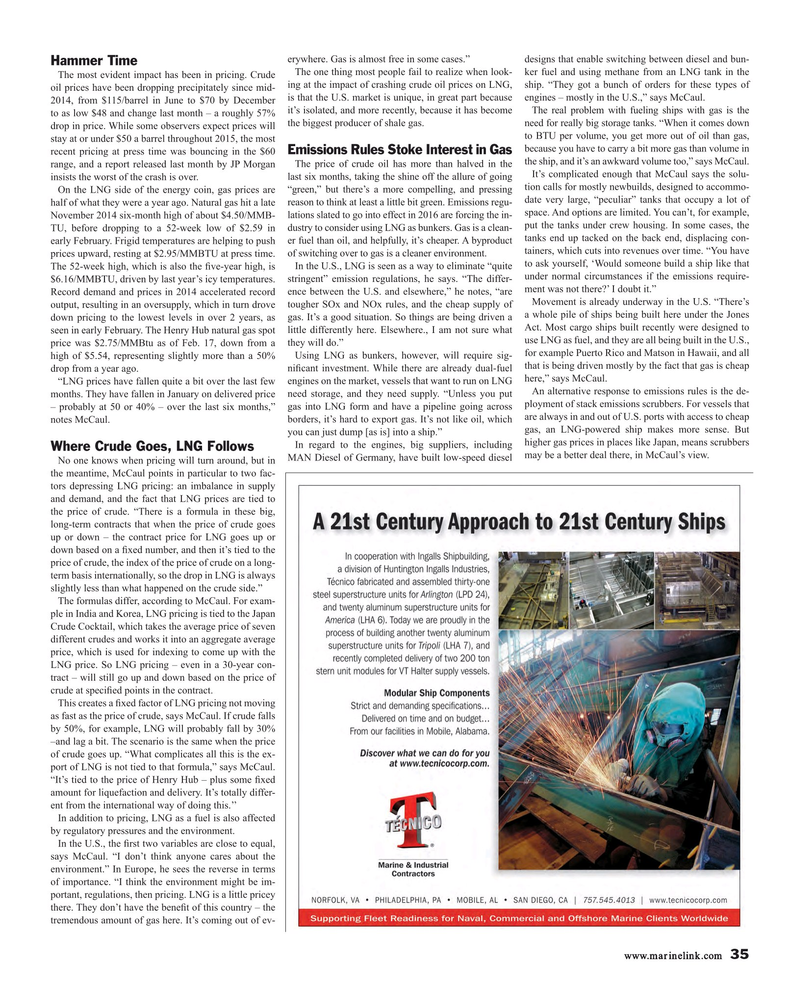
Page 35: of Maritime Reporter Magazine (June 2015)
Annual World Yearbook
Read this page in Pdf, Flash or Html5 edition of June 2015 Maritime Reporter Magazine
erywhere. Gas is almost free in some cases.” designs that enable switching between diesel and bun-
Hammer Time
The one thing most people fail to realize when look- ker fuel and using methane from an LNG tank in the
The most evident impact has been in pricing. Crude oil prices have been dropping precipitately since mid- ing at the impact of crashing crude oil prices on LNG, ship. “They got a bunch of orders for these types of 2014, from $115/barrel in June to $70 by December is that the U.S. market is unique, in great part because engines – mostly in the U.S.,” says McCaul. to as low $48 and change last month – a roughly 57% it’s isolated, and more recently, because it has become The real problem with fueling ships with gas is the drop in price. While some observers expect prices will the biggest producer of shale gas. need for really big storage tanks. “When it comes down to BTU per volume, you get more out of oil than gas, stay at or under $50 a barrel throughout 2015, the most because you have to carry a bit more gas than volume in
Emissions Rules Stoke Interest in Gas recent pricing at press time was bouncing in the $60
The price of crude oil has more than halved in the the ship, and it’s an awkward volume too,” says McCaul. range, and a report released last month by JP Morgan
It’s complicated enough that McCaul says the solu- insists the worst of the crash is over. last six months, taking the shine off the allure of going
On the LNG side of the energy coin, gas prices are “green,” but there’s a more compelling, and pressing tion calls for mostly newbuilds, designed to accommo- date very large, “peculiar” tanks that occupy a lot of half of what they were a year ago. Natural gas hit a late reason to think at least a little bit green. Emissions regu- space. And options are limited. You can’t, for example,
November 2014 six-month high of about $4.50/MMB- lations slated to go into effect in 2016 are forcing the in- put the tanks under crew housing. In some cases, the
TU, before dropping to a 52-week low of $2.59 in dustry to consider using LNG as bunkers. Gas is a clean- early February. Frigid temperatures are helping to push er fuel than oil, and helpfully, it’s cheaper. A byproduct tanks end up tacked on the back end, displacing con- tainers, which cuts into revenues over time. “You have prices upward, resting at $2.95/MMBTU at press time. of switching over to gas is a cleaner environment.
In the U.S., LNG is seen as a way to eliminate “quite to ask yourself, ‘Would someone build a ship like that
The 52-week high, which is also the ? ve-year high, is under normal circumstances if the emissions require- $6.16/MMBTU, driven by last year’s icy temperatures. stringent” emission regulations, he says. “The differ-
Record demand and prices in 2014 accelerated record ence between the U.S. and elsewhere,” he notes, “are ment was not there?’ I doubt it.”
Movement is already underway in the U.S. “There’s output, resulting in an oversupply, which in turn drove tougher SOx and NOx rules, and the cheap supply of down pricing to the lowest levels in over 2 years, as gas. It’s a good situation. So things are being driven a a whole pile of ships being built here under the Jones seen in early February. The Henry Hub natural gas spot little differently here. Elsewhere., I am not sure what Act. Most cargo ships built recently were designed to use LNG as fuel, and they are all being built in the U.S., price was $2.75/MMBtu as of Feb. 17, down from a they will do.” for example Puerto Rico and Matson in Hawaii, and all high of $5.54, representing slightly more than a 50% Using LNG as bunkers, however, will require sig- ni? cant investment. While there are already dual-fuel that is being driven mostly by the fact that gas is cheap drop from a year ago.
here,” says McCaul. “LNG prices have fallen quite a bit over the last few engines on the market, vessels that want to run on LNG
An alternative response to emissions rules is the de- months. They have fallen in January on delivered price need storage, and they need supply. “Unless you put – probably at 50 or 40% – over the last six months,” gas into LNG form and have a pipeline going across ployment of stack emissions scrubbers. For vessels that borders, it’s hard to export gas. It’s not like oil, which are always in and out of U.S. ports with access to cheap notes McCaul.
gas, an LNG-powered ship makes more sense. But you can just dump [as is] into a ship.”
In regard to the engines, big suppliers, including higher gas prices in places like Japan, means scrubbers
Where Crude Goes, LNG Follows
No one knows when pricing will turn around, but in MAN Diesel of Germany, have built low-speed diesel may be a better deal there, in McCaul’s view. the meantime, McCaul points in particular to two fac- tors depressing LNG pricing: an imbalance in supply and demand, and the fact that LNG prices are tied to the price of crude. “There is a formula in these big, long-term contracts that when the price of crude goes up or down – the contract price for LNG goes up or down based on a ? xed number, and then it’s tied to the price of crude, the index of the price of crude on a long- term basis internationally, so the drop in LNG is always slightly less than what happened on the crude side.”
The formulas differ, according to McCaul. For exam- ple in India and Korea, LNG pricing is tied to the Japan
Crude Cocktail, which takes the average price of seven different crudes and works it into an aggregate average price, which is used for indexing to come up with the
LNG price. So LNG pricing – even in a 30-year con- tract – will still go up and down based on the price of crude at speci? ed points in the contract.
This creates a ? xed factor of LNG pricing not moving as fast as the price of crude, says McCaul. If crude falls by 50%, for example, LNG will probably fall by 30% –and lag a bit. The scenario is the same when the price of crude goes up. “What complicates all this is the ex- port of LNG is not tied to that formula,” says McCaul. “It’s tied to the price of Henry Hub – plus some ? xed amount for liquefaction and delivery. It’s totally differ- ent from the international way of doing this.’’
In addition to pricing, LNG as a fuel is also affected by regulatory pressures and the environment.
In the U.S., the ? rst two variables are close to equal, says McCaul. “I don’t think anyone cares about the environment.” In Europe, he sees the reverse in terms of importance. “I think the environment might be im- portant, regulations, then pricing. LNG is a little pricey there. They don’t have the bene? t of this country – the tremendous amount of gas here. It’s coming out of ev- www.marinelink.com 35
MR #6 (34-41).indd 35 MR #6 (34-41).indd 35 6/8/2015 9:37:10 AM6/8/2015 9:37:10 AM

 34
34

 36
36
